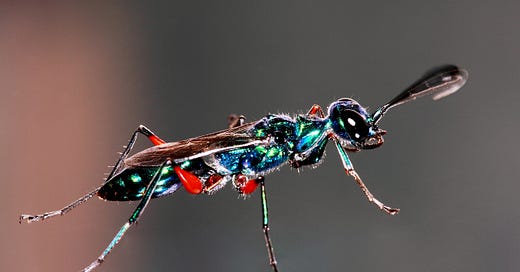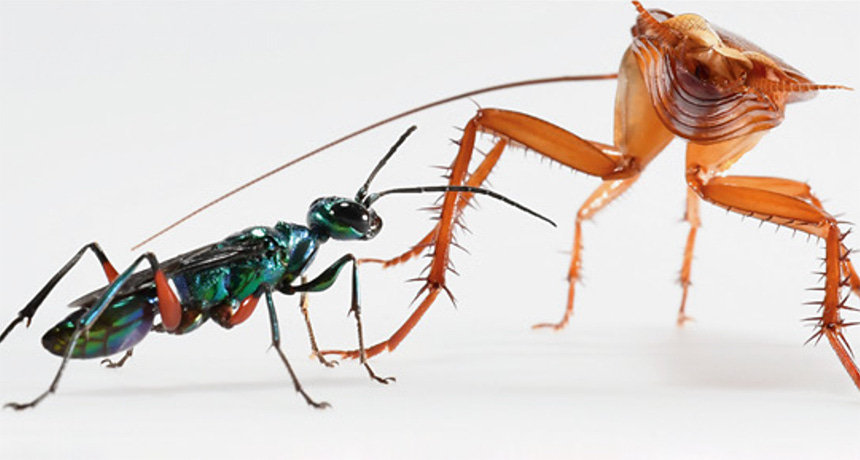Happy Halloween From This Heart-Eating Wasp
Don't worry. Cockroach hearts. We're talking 'bout cockroach hearts.
“If you loathe cockroaches, you’re going to love the emerald jewel wasp.”
That’s how my story for the New York Times this week begins. And I stand by it. Though I also realize many of you will find it hard to believe that a wasp can be lovable. So let’s back up a second.
When I said wasp just now, I’ll bet your brain instantly pictured a yellowjacket or paper wasp. Maybe a bald-faced hornet (which is not actually a hornet, but a poorly-named wasp). Because these are the species we most often think of as proper wasps.
But did you know the stingy things that live in large colonies and sometimes envenomate humans—what scientists call “social wasps”—are overwhelmingly outnumbered by solitary wasp species?
In fact, when I interviewed Chris Alice Kratzer, an entomologist and author of The Social Wasps of North America, for my book chapter on yellowjackets, she told me that there are just over 200 species of social wasps in North America. But there are like 114,000 wasp species on this planet!
This means that the vast majority of wasps do not make hives (or honey), do not dive-bomb picnics, and couldn’t even sting you if they wanted to. (Note: No wasp wants to sting you, but we don’t have time for that little diatribe today.)
So what are all of those other waspies doing with their little lives? Well, a whole lot of them are wandering through the world looking for a nice creature to turn into a zombie nanny for their kiddos.
And that brings us back to the emerald jewel wasp (Ampulex compressa), which I feel like at this point you should just see, because they’re oil-on-a-puddle gorgeous.

About as big as two Skittles in a row, these tiny, female wasps are formidable cockroach hunters. Which is rather impressive when you consider that the cockroaches they target—another poorly named insect called the American cockroach (Periplanata americana), which is not actually native to any of the Americas—are massive, armored, and bristling with weaponry.
Wondering what kind of weapons a cockroach has?
Well, have you ever really looked at one? I mean, really looked? Most of us haven’t. When we see them, we stomp on sight. But American cockroach legs are basically baseball bats wrapped in barbed wire. And if they detect an emerald jewel wasp sniffing around, they will use those babies to karate kick like there’s no tomorrow, which there isn’t for the cockroach, if the wasp succeeds in its attack.
Now, anyone who has ever tried to squash a cockroach knows that the buggers are incredibly fleet of foot. It’s almost as if they know what you’re going to do before you do it. But cockroaches aren’t telepathic. They’re pressure-sensitive.
Here’s how neuroecologist Kenneth Catania describes it in his fantastic book, Great Adaptations: Star-Nosed Moles, Electric Eels, and Other Tales of Evolution’s Mysteries Solved.
The American cockroach has two appendages, called cerci, that stick up from its rear end. These are covered with microscopic hairs that detect the hallmark "pressure wave" of air preceding the impact of a striking predator (or striking shoe). The hairs are connected to giant neurons that detect not only the imminent impact but also (like fish ears) the direction from which the attack was launched. Within a hundredth of a second, the cockroach begins its turn away and its flight, or perhaps I should say scuttle, to safety. This escape system is well-known to many scientists and students and is used as a model for understanding how sensory stimuli and neural networks produce simple behaviors.
Ah, but this is where it pays to be little. Emerald jewel wasps are so much smaller than their adversary, their movements don’t trip the cockroach’s sensors. So sometimes they’re able to sneak up on the hulking insect and latch on before the cockroach even knows they’re there.
And this is where things get a bit Halloween-y.
How To Make A Zombie
Female emerald jewel wasps have long, flexible stingers that they can control. And they use these highly-evolved devices to probe the cockroach’s exoskeleton for gaps so they can make a series of two unbelievably accurate stings.
The first sting happens in the thorax, or the cockroach’s middle section. But it’s not as if the wasp just stabs her pointy end into the cockroach and squirts her venom. No, this stinger has sensors which direct the hypodermic needle to the thoracic ganglion, or the group of nerves that controls the cockroach’s front legs. Venom here disables the much larger insect and stops it from bucking like a bronco.
With the cockroach’s legs paralyzed, the wasp next snakes its stinger into the brain, where its sensors again guide it to a sweet spot so that the next dose of venom can do something exceedingly strange—turn the cockroach into the living dead.
Once it’s been stung in the brain, the cockroach can still walk, swim, and even fly, but it no longer seems to have any concern for its own self-preservation. It stops fighting back against the wasp entirely, and doesn’t even run away when the wasp snips its highly-sensitive antennae and starts to drink the hemolymph (insect blood) that seeps out. Creepiest of all, when the wasp begins to tug on those same severed antennae, the cockroach follows like a whipped dog.
Catania describes the now-zombified cockroach as having had an “attitude adjustment.” Unfortunately for the cockroach, the worst is yet to come.
The Needle And The Damage Done
With its new pet drugged and docile, the wasp sets out on a quest to find a nice, cozy hole in the ground. The crevice needs to be large enough to stow a cockroach, and it needs to be near enough to some building materials. Because what happens next is all kinds of extra.
You see, the wasp hasn’t done all of this so that she can eat the cockroach. No. She’s preparing a subterranean nursery for her next of kin.
Once she finds the hidey hole, she drags the roach there by its antennae. (The first, paralyzing sting wears off while she’s touring local real estate.) After she tucks the roach into its final resting place, the wasp momma lays a single egg on her victim’s leg.
Then, the mother wasp exits the crypt and seals the door up behind her with sticks, dirt, and debris.
In six days, the wasp egg hatches into a wriggly little larva. And like The Very Hungry Caterpillar, this wasp baby is hangry. So it chews its way into the cockroach’s chest and begins to devour the bug from the inside out.
By the way, this is where you should hop on over to my story at the New York Times, because Catania has discovered some diabolical details about wasp larvae savagery that will blow your mind. Spoiler: Some of it has to do with heart-eating. Oh, and he kept the receipts. (He has video, is what I’m trying to say!)
Eventually, the cockroach tastes the sweet relief of death, but only after about 48 hours of being gutted by the ravenous offspring of its mortal enemy. And there’s still one more indignity to suffer—after it’s eaten its fill, the wasp larva uses the cockroach’s hollowed out corpse as a transition chamber where it can metamorphosize into an adult, at which point it will do its best impression of a chest-burster from Alien.
Oh, and if you’re thinking a cockroach carcass seems like a pretty dirty place to grow up, well don’t worry. Before it curls up for its transformation, the wasp larvae spritzes the whole place in antibiotic compounds.
Happy Halloween From All of Nature’s Hellraisers!
Look, today it’s parasitic wasps, but this post could easily have been about white-tailed deer, who sometimes eat baby birds out of their nests, or red squirrels, who routinely practice infanticide and cannibalism. Nature is a horror movie from start to finish, and the sooner you accept that, the sooner you will be able to more truly appreciate its beauty.
That’s right, I’m saying it can and should be both.
We can marvel at the bullseye accuracy of the wasp’s sting even as we cringe at the effect it has on another living creature. You can feel bad for the roach, or happy for the wasp mom and her baby—how’s that for the power of narrative?—but at the end of the day, this process has played out a bajillion times to get to this point. And what you’re witnessing is but one note among the symphony, a drop of rain in a hurricane.
It took hundreds of thousands if not millions of years for a dance like this to develop. And I’m simply bowled over by the fact that smart people like Catania have found ways to figure out even a fraction of what’s happening behind the scenes.
Speaking of cinematography, did I mention that Catania has been known to dabble in the visual arts? Before you log off or click away, I implore you to watch the video below, in which he sets an emerald jewel wasp and a cockroach loose in a diorama built from doll-house parts. It’s creepy as it is kooky, and the perfect illustration of why Hollywood will always be playing catchup when it comes to nature’s evolutionary imagination.
Enjoy, and Happy Halloween!







